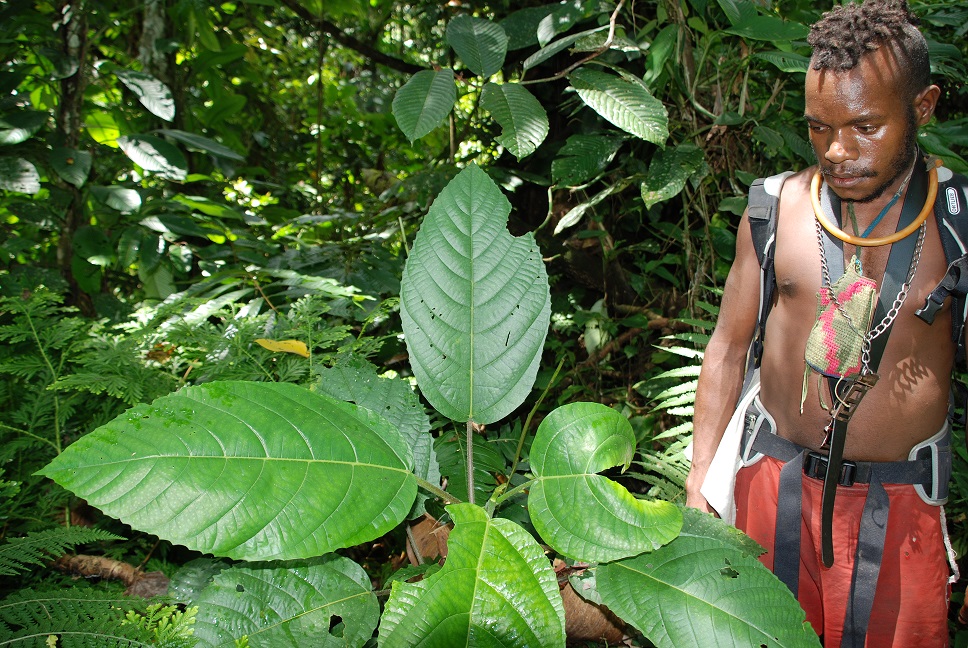Traditional Ecological Knowledge of the Meakambut, Papua New Guinea

Deposit page image for the collection “Traditional Ecological Knowledge of the Meakambut, Papua New Guinea”. Kaipas Yakalok with the stinging nettles. Click on image to access collection.
| Language | Meakambut |
| Depositor | Darja Hoenigman |
| Affiliation | The Australian National University |
| Location | Papua New Guinea |
| Collection ID | 0705 |
| Grant ID | MDP0441 |
| Funding Body | ELDP |
| Collection Status | Forthcoming |
| Landing page handle | http://hdl.handle.net/2196/92f2c99e-5c62-4210-8903-8dd976337c10 |
Summary of the collection
This deposit will be a result of a documentation of the traditional ecological knowledge of the Meakambut and Awiakay from Papua New Guinea, funded by ELDP between 2023–2025. The project is a collaborative effort between a linguistic anthropologist and Meakambut and Awiakay people, in collaboration with an ethnobotanist. The data deposited in this collection will encompass video-recordings of a wide variety of genres of language use related to TEK; a collection of short observational films about Meakambut speakers’ interaction with their environment, including landscapes, plants, animals and spirits; photographs and a list of identified specimens of the local flora and fauna; and a Meakambut–Tok Pisin–English photo-dictionary of local plants and animals.
Group represented
The group represented in this collection are the Meakambut from East Sepik Province of Papua New Guinea. Their language, Meakambut (also referred to as Meambul momba), has about 60 speakers and belongs to the Arafundi language family. Unlike their sedentary neighbours, Meakambut do not have a permanent settlement, but move in small groups between camps and rock shelters in their mountainous territory. They depend almost entirely on foraging, with sago as their staple. A recent discovery of gold in the region resulted in a goldrush, which is bringing along radical social changes…
This collection is part of the project that aims to document Meakambut and the neighbouring Awiakay traditional ecological knowledge (TEK) and language use related to TEK. This documentation will ensure that the detailed knowledge about plants and animals found in this ecological area and transmitted through the two languages, is not lost. The project builds on previous long-term ethnographic fieldwork with the two groups, including the documentation of Meakambut and Awiakay ways of speaking.
Awiakay: http://hdl.handle.net/2196/3e788cdb-8886-493c-8151-aeea0038969e; Meakambut: http://hdl.handle.net/2196/962989ef-7d37-4d3d-8dcf-0d1439e5c077 ; Awiakay: http://hdl.handle.net/2196/38f2j98o-5c72-0819-9909-8rz976330p83)
Special characteristics
This deposit will be a result of a collaborative effort of a linguistic anthropologist, Darja Hoenigman, with the Meakambut people, in collaboration with a botanist Janet Gagul from the University of Papua New Guinea.
The Meakambut and Awiakay land is a major lowland forest area with a very small human population. There is no major study of TEK from such an area in the Sepik region of Papua New Guinea.
Documentation of and Meakambut and Awiakay TEK at this particular moment in time will be a window on long-standing customs that intimately connect people’s lives to the environment, as well as the transmission of this knowledge in the context of changing linguistic practices and rapid social change that is endangering both the languages and the cultural heritage that lives through them.
Collection contents
This collection will include
— Video and audio recordings of Meakambut traditional ecological knowledge (TEK) and language use related to TEK. Genres to be documented will include:
– myths, songs and memories relating to knowledge of plants, animals and spirits
– natural verbal and non-verbal interactions with the local environment
– hunting practices and related communicative strategies
– narratives
– conversations
– interviews to elicit species names and associated information.
— A collection of short observational films about Meakambut speakers’ interaction with their environment, including landscapes, plants, animals and spirits.
— Photographs and a list of identified specimens of the local flora and fauna.
Specimens of the local flora will be deposited in the PNG National Herbarium in Lae.
Specimens of some insects and photographs of larger animals and birds will be deposited the New Guinea Binatang Research Centre in Madang.
— A Meakambut–Tok Pisin–English photo-dictionary of local plants and animals.
Collection history
Documentation for this project will start in 2023.
Acknowledgement and citation
Users of any part of this collection should acknowledge Darja Hoenigman as the principal investigator. Janet Gagul should be acknowledged as a core member of the research team in all plant-related parts of the collection (check metadata to confirm). The Endangered Languages Documentation Programme should be acknowledged as the funder of this project. Users of parts of the corpus should acknowledge by name the individuals appearing in the recordings whose words and/or images are used. Any other contributor involved in data collection, transcription and translation, or who contributed in any other way, should be acknowledged by name. All the relevant information is available in the metadata.
To refer to any data from the collection, please cite as follows:
Hoenigman, Darja. 2023. Traditional ecological knowledge of the Meakambut, Papua New Guinea. Endangered Languages Archive. Handle: http://hdl.handle.net/2196/12k2c89e-5c92-4710-8605-8ed976339f19. Accessed on [insert here].


